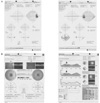Abstract
Septo-optic dysplasia (SOD) is a rare congenital malformation syndrome that is manifested by a triad of optic nerve hypoplasia, midline brain abnormalities and hypopituitarism. It is known to be associated with homeobox gene HESX1 mutation in some familial cases.
We experienced a case of SOD in a 23 year-old male who presented with short stature and delayed puberty. The basal serum levels of testosterone and IGF-1 were low and the prolactin level was high. The combined pituitary stimulation study revealed decreased growth hormone responses. Brain MRI revealed complete agenesis of the corpus callosum, hypoplasia of the anterior pituitary gland and herniation of the third ventricle into the pituitary fossa. On the neurologic and ophthalmologic examinations, there was no definite abnormality except mild optic atrophy on the optical coherence tomography. Genetic analysis using polymerase chain reaction with direct sequencing revealed no HESX1 mutation.
Figures and Tables
Fig. 1
Brain MRI. A, B. T1-weighted sagittal view showed complete agenesis of corpus callosum and septum pellucidum. Hypoplasia of anterior pituitary gland and ectopic location of posterior pituitary gland were observed. Herniation of infundibular recess of the third ventricle into pituitary fossa was noted. C. There was no corpus callosum or anterior commisure in T2-weighted axial view. D. Ectopic posterior pituitary gland was well visualized in T1-weighted coronal view.

Fig. 2
Ophthalmologic examination. A. Visual field analysis showed generalized reduction of sensitivity without significant visual field defect in both eyes. B. Optical coherence tomography showed focal retinal nerve fiber layer defect in superior segments of optic nerve head in both eyes (red arrow) suggesting mild optic nerve hypoplasia.

References
1. Dattani MT, Robinson IC. The molecular basis for developmental disorders of the pituitary gland in man. Clin Genet. 2000. 57:337–346.
2. De Morsier G. Studies on malformation of cranio -encephalic sutures. III. Agenesis of the septum pellucidum with malformation of the optic tract. Schweiz Arch Neurol Psychiatr. 1956. 77:267–292.
3. Haddad NG, Eugster EA. Hypopituitarism and neurodevelopmental abnormalities in relation to central nervous system structural defects in children with optic nerve hypoplasia. J Pediatr Endocrinol Metab. 2005. 18:853–858.
4. Traggiai C, Stanhope R. Endocrinopathies associated with midline cerebral and cranial malformations. J Pediatr. 2002. 140:252–255.
5. Lee Won Hae, Park Song Hee, Shin Hanho. A case of septo-optic dysplasia. J Kor Ophth Soc. 1991. 32:110–116.
6. Kim Soo Kyoung, Jung Tae Sik, Hahm Jong Ryeal, Lee Sang Min, Moon Sung Won, Lee Kyeong Ju, Chung Soon Il. A case of central diabetes insipidus combined with septo-optic dysplasia and schizencephaly in 31-year-old woman. J Kor Endocrine Soc. 2007. 22:339–343.
7. De Morsier G. Median cranioencephalic dysraphias and olfactogenital dysplasia. World Neurol. 1962. 3:485–506.
8. Hoyt WF, Kaplan SL, Grumbach MM, Glaser JS. Septo-optic dysplasia and pituitary dwarfism. Lancet. 1970. 1:893–894.
9. Billson FA, Hopkins IJ. Optic hypoplasia and hypopituitarism. Lancet. 1972. 1:905.
10. Dattani MT, Preece M. Growth hormone deficiency and related disorders: insights into causation, diagnosis, and treatment. Lancet. 2004. 363:1977–1987.
11. Wales JK, Quarrell OW. Evidence for possible Mendelian inheritance of septo-optic dysplasia. Acta Paediatr. 1996. 85:391–392.
12. Thomas PQ, Dattani MT, Brickman JM, McNay D, Warne G, Zacharin M, Cameron F, Hurst J, Woods K, Dunger D, Stanhope R, Forrest S, Robinson IC, Beddington RS. Heterozygous HESX1 mutations associated with isolated congenital pituitary hypolasia and septo-optic dysplasia. Hum Mol Genet. 2001. 10:39–45.
13. Dattani MT, Martinez-Barbera JP, Thomas PQ, Brickman JM, Gupta R, Martensson IL, Toresson H, Fox M, Wales JK, Hindmarsh PC, Krauss S, Beddington RS, Robinson IC. Mutations in the homeobox gene HESX1/Hesx1 associated with septo-optic dysplasia in human and mouse. Nat Genet. 1998. 19:125–133.
14. Kelberman D, Dattani MT. Septo-Optic Dysplasia-Novel insights into the aetiology. Horm Res. 2008. 69:257–265.
15. Donat JF. Septo-optic dysplasia in an infant of a diabetic mother. Arch Neurol. 1981. 38:590–591.
16. Parson SH, Dhillon B, Findlater GS, Kaufman MH. Optic nerve hypoplasia in the fetal alcohol syndrome: a mouse model. J Anat. 1995. 186(Pt 2):313–320.
17. Hoyt CS, Billson FA. Maternal anticonvulsants and optic nerve hypoplasia. Br J Ophthalmol. 1978. 62:3–6.
18. Dominguez R, Aguirre Vila-Coro A, Slopis JM, Bohan TP. Brain and ocular abnormalities in infants with in utero exposure to cocaine and other street drugs. Am J Dis Child. 1991. 145:688–695.
19. Woods K, Dattani MT. Epstein J, Wynshaw-Boris. AJ, editors. Transcription factors involved in disorders of forebrain and pituitary development. Inborn Errors of Development: The Molecular Basis of Clinical Disorders on Morphogenesis. 2004. New York: Oxford University Press;540–551.
20. Birkebaek NH, Patel L, Wright NB, Grigg JR, Sinha S, Hall CM, Price DA, Lloyd IC, Clayton PE. Endocrine status in patients with optic nerve hypoplasia: relationship to midline central nervous system abnormalities and appearance of the hypothalamic-pituitary axis on magnetic resonance imaging. J Clin Endocrinol Metab. 2003. 88:5281–5286.




 PDF
PDF ePub
ePub Citation
Citation Print
Print




 XML Download
XML Download